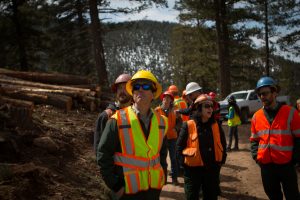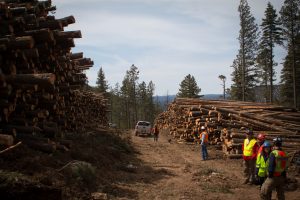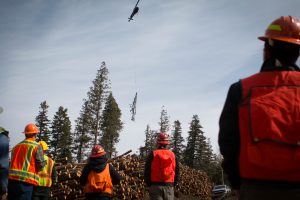- Slug: BC-CNS-Helicopter Logging. 660 words.
- 4 photos and captions below.
By NICOLE HERNANDEZ
Cronkite News
FLAGSTAFF – On Mount Elden’s tightly wound switchbacks, small pines densely line the edge of the cliff just off the dirt road. Many are marked with brilliant orange spray paint, signaling a boundary that tells loggers where to remove trees.
The mountain’s steep slopes and the crowded forest makes getting trees off Elden a challenge, so R&R Conner Helicopters project manager Dave Webb and his crew of 16 take the pines out by air.
A constant whoosh from the chopper’s blades echoes against the mountainside as Webb’s crew flies back and forth, grabbing trees and dropping them at a landing area where the felled trees are trimmed and stacked.
“This is what happens every day,” Webb said.
With the threat of wildfires expected to be higher than normal this fire season, Flagstaff is trying to reduce the threat by logging with a helicopter. This work is expected to be finished by mid-May.
It’s an expensive undertaking. Flagstaff residents in 2012 voted to tax themselves to raise the funds, compiling $10 million dedicated expressly to reducing the risk of wildfires near the city.
The thinning project is funded by that tax money, along with $3 million the U.S. Forest Service invested in the Flagstaff Watershed Protection Project, which includes Mount Elden, just east of the city.
“Per hour, it’s thousands of dollars,” Webb said. “So we have to keep things moving. … The helicopter goes back and forth probably 250 times a day like this … and it varies from one to 10 trees at a time.”
Since January, weather permitting, the helicopter has flown every workday, removing thousands of pines that were growing too closely together and creating greater fire risks.
“A lot of times, people’s vision of a forest is a really dense stand of trees, which actually in this area is not true natural conditions for the forest,” said Matt McGrath, the district ranger for the Forest Service’s Flagstaff Ranger District.
When trees grow as densely as they have on Mount Elden, wildfires can spread quickly because the flames easily jump from trunk to trunk. And once a fire occurs, the impacts extend beyond the land that burned.
Flagstaff’s watershed provides drinking water to the city. But after a wildfire, runoff in the watershed picks up residual ash and debris, making it unusable.
Wildfires also damage the soil so drastically that it no longer can absorb water, McGrath said, which creates the potential for severe flooding in Flagstaff.
Beyond preventing catastrophic damage, the thinning will make the forest healthier by allowing trees to grow to their natural sizes, McGrath said.
George Jozens, a spokesman for the Coconino National Forest, said loggers are not cutting down any mature pines, which makes it harder to get rid of the thousands of smaller trunks piled in the landing area, waiting to be trucked the rest of the way down the mountain. Jozens said the plan is to sell the lumber, but most companies will only buy trees of larger diameters. He said there’s no set plan for the piles, but they likely will be sold for fire fuel.
The trees being cut and sold this year are the second phase of the Flagstaff Watershed Protection Project. The first phase, completed in 2018, involved removing trees from the base of Mount Elden through traditional logging and prescribed burns.
More than 9,000 acres of city and federal land has been thinned since the start of the project in 2012. The final phase will focus on thinning the forests on Mormon Mountain, about an hour south of Flagstaff.
“This area of the forest, it took a lot of years for it to get as overgrown as it is,” McGrath said. “So we’re doing a lot of work to undo a lot of years of overgrowth.”
This story is part of Elemental: Covering Sustainability, a new multimedia collaboration between Cronkite News, Arizona PBS, KJZZ, KPCC, Rocky Mountain PBS and PBS SoCal.
For more stories from Cronkite News, visit cronkitenews.azpbs.org.
^_=


